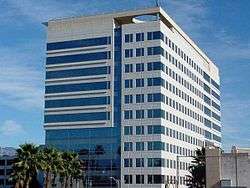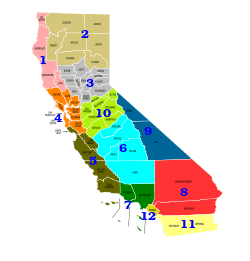California Department of Transportation
 | |
| Agency overview | |
|---|---|
| Formed |
1895 as Bureau of Highways 1972 as Caltrans |
| Preceding agencies |
|
| Headquarters | 1120 N Street, Sacramento, California |
| Employees | 18,415 permanent staff |
| Annual budget | US$17 billion (2016)[1] |
| Agency executive |
|
| Parent agency | California State Transportation Agency |
| Website | dot.ca.gov |
| Footnotes | |
| [2] | |
The California Department of Transportation (Caltrans) is an executive department within the U.S. state of California.
Caltrans manages the state highway system (which includes the California Freeway and Expressway System) and is involved with public transportation systems throughout the state. It supports Amtrak California and the Capitol Corridor.
The department is part of the state cabinet-level California State Transportation Agency (CalSTA).
Like the majority of state government agencies, Caltrans is headquartered in Sacramento.[3]
In 2015, Caltrans released a new mission statement: "Provide a safe, sustainable, integrated and efficient transportation system to enhance California’s economy and livability." [4]
History


The earliest predecessor of Caltrans was the Bureau of Highways, which was created by the California Legislature and signed into law by Governor James Budd in 1895.[5] This agency consisted of three commissioners who were charged with analyzing the state road system and making recommendations. At the time, there was no state highway system, since roads were purely a local responsibility. California's roads consisted of crude dirt roads maintained by county governments, as well as some paved roads within city boundaries, and this ad hoc system was no longer adequate for the needs of the state's rapidly growing population. After the commissioners submitted their report to the governor on November 25, 1896, the legislature replaced the Bureau with the Department of Highways.[6]
Due to the state's weak fiscal condition and corrupt politics, little progress was made until 1907, when the legislature replaced the Department of Highways with the Department of Engineering, within which there was a Division of Highways.[5] Voters approved an $18 million bond issue for the construction of a state highway system in 1910, and the first Highway Commission was convened in 1911.[5] On August 7, 1912, the department broke ground on its first construction project, the section of El Camino Real between South San Francisco and Burlingame (now part of California State Route 82).[7] The year 1912 also saw the founding of the Transportation Laboratory and the creation of seven administrative divisions (the predecessors of the 12 district offices that exist today).[5] The original seven headquarters were located in:[8]
- Willits[note 1] Mercantile Building for Del Norte, Humboldt, Lake, and Mendocino Counties
- Redding C.R.Briggs Building for Lassen, Modoc, Shasta, Siskiyou, Tehama, and Trinity Counties
- Sacramento Forum Building for Alpine, Amador, Butte, Calaveras, Colusa, El Dorado, Glenn, Nevada, Placer, Plumas,Sacramento, San Joaquin, Sierra, Solano, Stanislaus, Sutter, Tuolumne, Yolo, and Yuba Counties
- San Francisco Rialto Building for Alameda, Contra Costa, Marin, Napa, San Francisco, Santa Clara, Santa Cruz, San Mateo, and Sonoma Counties
- San Luis Obispo Union National Bank Building for Monterey, San Benito, Santa Barbara, and San Luis Obispo Counties
- Fresno Forsythe Building[note 2] for Fresno, Inyo, Kern, Kings, Madera, Mariposa, Merced, Mono, and Tulare Counties
- Los Angeles Union Oil Building for Imperial, Los Angeles, Orange, Riverside, San Bernardino, San Diego, and Ventura Counties
In 1913, the legislature started requiring vehicle registration and allocated the resulting funds to support regular highway maintenance, which began the next year.[5]
In 1921, the legislature turned the Department of Engineering into the Department of Public Works.[9]
The history of Caltrans and its predecessor agencies during the 20th century was marked by many firsts. It was one of the first agencies in the United States to paint centerlines on highways statewide (thanks to June McCarroll); the first to build a freeway west of the Mississippi River (the Pasadena Freeway); the first to build a four-level stack interchange; the first to develop and deploy non-reflective raised pavement markers, better known as Botts' dots; and one of the first to implement dedicated freeway-to-freeway connector ramps for high-occupancy vehicle lanes.
In late 1972, the legislature approved a reorganization (suggested in a study initiated by then-Governor Ronald Reagan) in which the Department of Public Works was merged with the Department of Aeronautics to become the modern Department of Transportation.[10]

Administration
For administrative purposes, Caltrans divides the State of California into 12 districts, supervised by district offices. Most districts cover multiple counties; District 12 (Orange County) is the only district with one county. The largest districts by population are District 4 (San Francisco Bay Area) and District 7 (Los Angeles and Ventura counties). Like most state agencies, Caltrans maintains its headquarters in Sacramento, which is covered by District 3.
Districts

| District[11] | Area (Counties) | Headquarters |
|---|---|---|
| 1 | Del Norte, Humboldt, Lake, Mendocino | Eureka |
| 2 | Lassen, Modoc, Plumas, Shasta, Siskiyou, Tehama, Trinity; portions of Butte and Sierra | Redding |
| 3 | Butte, Colusa, El Dorado, Glenn, Nevada, Placer, Sacramento, Sierra, Sutter, Yolo,Yuba | Marysville |
| 4 | Alameda, Contra Costa, Marin, Napa, San Francisco, San Mateo, Santa Clara, Solano, Sonoma, | Oakland |
| 5 | Monterey, San Benito, San Luis Obispo, Santa Barbara, Santa Cruz | San Luis Obispo |
| 6 | Madera, Fresno, Tulare, Kings, and western Kern County | Fresno |
| 7 | Los Angeles, Ventura | Los Angeles |
| 8 | Riverside, San Bernardino | San Bernardino |
| 9 | Inyo, Mono, and eastern Kern County | Bishop |
| 10 | Alpine, Amador, Calaveras, Mariposa, Merced, San Joaquin, Stanislaus, Tuolumne | Stockton |
| 11 | Imperial, San Diego | San Diego |
| 12 | Orange | Santa Ana[12] |
See also
Notes
- ↑ Willits was the northernmost California Coast Range city connected to the national rail network when the headquarters were established there.
- ↑ The Forsythe Building was shared with the original Gottschalks department store.
References
- ↑ Taylor, Mac. "The 2016-17 Budget Transportation Proposals" (PDF). Legislative Analyst's Office. Legislative Analyst's Office of California. Retrieved 21 September 2016.
- ↑ "Caltrans Executive Fact Book" (PDF). May 2016.
- ↑ "Caltrans Mail Addresses." California Department of Transportation. Retrieved on November 19, 2009.
- ↑ Caltrans, State of California,. "Caltrans Mission, Vision, Goals & Values". dot.ca.gov. Retrieved 2016-09-26.
- 1 2 3 4 5 Raymond Forsyth and Joseph Hagwood, One Hundred Years of Progress (Sacramento: California Transportation Foundation, 1996): 11
- ↑ Raymond Forsyth and Joseph Hagwood, One Hundred Years of Progress (Sacramento: California Transportation Foundation, 1996): 12.
- ↑ Raymond Forsyth and Joseph Hagwood, One Hundred Years of Progress (Sacramento: California Transportation Foundation, 1996): 13.
- ↑ Ellis, W.R. (1913). "Division Engineers - Office Addresses". California Highway Bulletin. California Highway Commission. 1 (2): 2&3.
- ↑ Raymond Forsyth and Joseph Hagwood, One Hundred Years of Progress (Sacramento: California Transportation Foundation, 1996): 32.
- ↑ Raymond Forsyth and Joseph Hagwood, One Hundred Years of Progress (Sacramento: California Transportation Foundation, 1996): 128.
- ↑ "Caltrans District Offices". California Department of Transportation. Retrieved 2010-02-13.
- ↑ "News Release D12 Move to Santa Ana October 2016 (PDF)" (PDF).
External links
| Wikimedia Commons has media related to California Department of Transportation. |
- Official California Department of Transportation website
- Named Highways, Freeways, Structures, and Other Appurtenances in California (PDF)